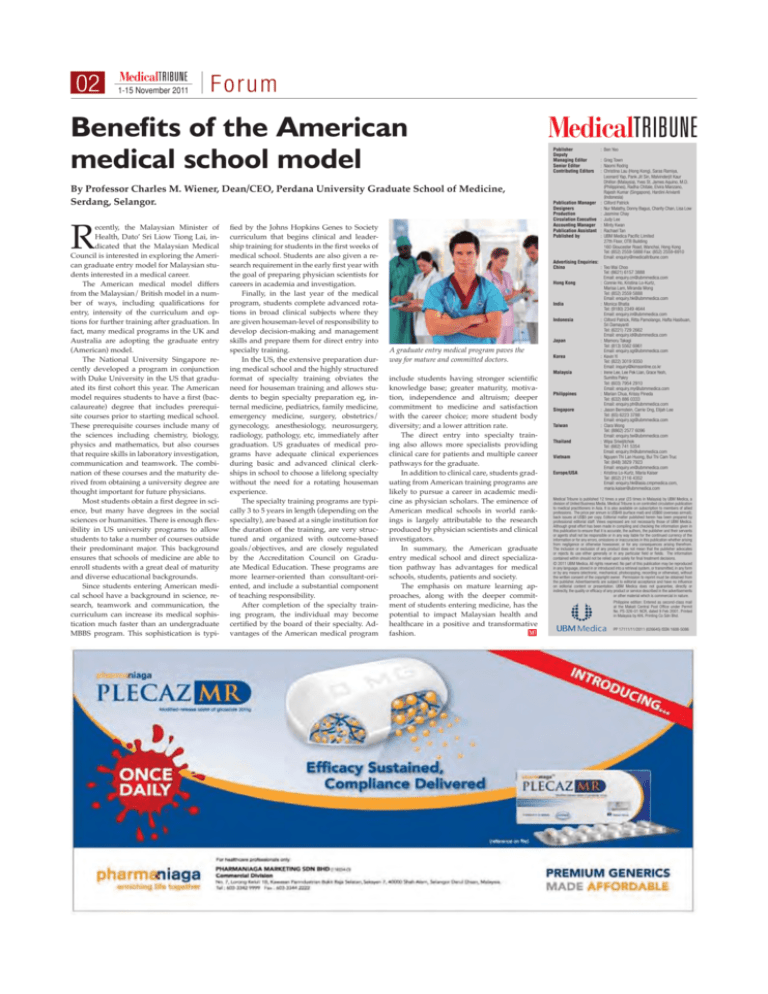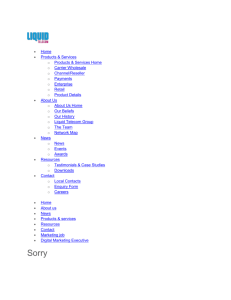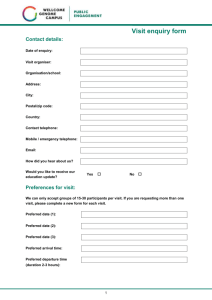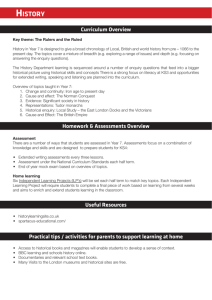
02
1-15 November 2011
Forum
Benefits of the American
medical school model
By Professor Charles M. Wiener, Dean/CEO, Perdana University Graduate School of Medicine,
Serdang, Selangor.
R
ecently, the Malaysian Minister of
Health, Dato’ Sri Liow Tiong Lai, indicated that the Malaysian Medical
Council is interested in exploring the American graduate entry model for Malaysian students interested in a medical career.
The American medical model differs
from the Malaysian/ British model in a number of ways, including qualifications for
entry, intensity of the curriculum and options for further training after graduation. In
fact, many medical programs in the UK and
Australia are adopting the graduate entry
(American) model.
The National University Singapore recently developed a program in conjunction
with Duke University in the US that graduated its first cohort this year. The American
model requires students to have a first (baccalaureate) degree that includes prerequisite courses prior to starting medical school.
These prerequisite courses include many of
the sciences including chemistry, biology,
physics and mathematics, but also courses
that require skills in laboratory investigation,
communication and teamwork. The combination of these courses and the maturity derived from obtaining a university degree are
thought important for future physicians.
Most students obtain a first degree in science, but many have degrees in the social
sciences or humanities. There is enough flexibility in US university programs to allow
students to take a number of courses outside
their predominant major. This background
ensures that schools of medicine are able to
enroll students with a great deal of maturity
and diverse educational backgrounds.
Since students entering American medical school have a background in science, research, teamwork and communication, the
curriculum can increase its medical sophistication much faster than an undergraduate
MBBS program. This sophistication is typi-
fied by the Johns Hopkins Genes to Society
curriculum that begins clinical and leadership training for students in the first weeks of
medical school. Students are also given a research requirement in the early first year with
the goal of preparing physician scientists for
careers in academia and investigation.
Finally, in the last year of the medical
program, students complete advanced rotations in broad clinical subjects where they
are given houseman-level of responsibility to
develop decision-making and management
skills and prepare them for direct entry into
specialty training.
In the US, the extensive preparation during medical school and the highly structured
format of specialty training obviates the
need for houseman training and allows students to begin specialty preparation eg, internal medicine, pediatrics, family medicine,
emergency medicine, surgery, obstetrics/
gynecology, anesthesiology, neurosurgery,
radiology, pathology, etc, immediately after
graduation. US graduates of medical programs have adequate clinical experiences
during basic and advanced clinical clerkships in school to choose a lifelong specialty
without the need for a rotating houseman
experience.
The specialty training programs are typically 3 to 5 years in length (depending on the
specialty), are based at a single institution for
the duration of the training, are very structured and organized with outcome-based
goals/objectives, and are closely regulated
by the Accreditation Council on Graduate Medical Education. These programs are
more learner-oriented than consultant-oriented, and include a substantial component
of teaching responsibility.
After completion of the specialty training program, the individual may become
certified by the board of their specialty. Advantages of the American medical program
A graduate entry medical program paves the
way for mature and committed doctors.
include students having stronger scientific
knowledge base; greater maturity, motivation, independence and altruism; deeper
commitment to medicine and satisfaction
with the career choice; more student body
diversity; and a lower attrition rate.
The direct entry into specialty training also allows more specialists providing
clinical care for patients and multiple career
pathways for the graduate.
In addition to clinical care, students graduating from American training programs are
likely to pursue a career in academic medicine as physician scholars. The eminence of
American medical schools in world rankings is largely attributable to the research
produced by physician scientists and clinical
investigators.
In summary, the American graduate
entry medical school and direct specialization pathway has advantages for medical
schools, students, patients and society.
The emphasis on mature learning approaches, along with the deeper commitment of students entering medicine, has the
potential to impact Malaysian health and
healthcare in a positive and transformative
fashion.
Publisher
Deputy
Managing Editor
Senior Editor
Contributing Editors
: Ben Yeo
: Greg Town
: Naomi Rodrig
: Christina Lau (Hong Kong), Saras Ramiya,
Leonard Yap, Pank Jit Sin, Malvinderjit Kaur
Dhillon (Malaysia), Yves St. James Aquino, M.D.
(Philippines), Radha Chitale, Elvira Manzano,
Rajesh Kumar (Singapore), Hardini Arivianti
(Indonesia)
Publication Manager : Cliford Patrick
Designers
: Nur Malathy, Donny Bagus, Charity Chan, Lisa Low
Production
: Jasmine Chay
Circulation Executive : Judy Lee
Accounting Manager : Minty Kwan
Publication Assistant : Rachael Tan
Published by
: UBM Medica Pacific Limited
27th Floor, OTB Building
160 Gloucester Road, Wanchai, Hong Kong
Tel: (852) 2559-5888 Fax: (852) 2559-6910
Email: enquiry@medicaltribune.com
Advertising Enquiries:
China
: Teo Wai Choo
Tel: (8621) 6157 3888
Email: enquiry.cn@ubmmedica.com
Hong Kong
: Connie Ho, Kristina Lo-Kurtz,
Marisa Lam, Miranda Wong
Tel: (852) 2559 5888
Email: enquiry.hk@ubmmedica.com
India
: Monica Bhatia
Tel: (9180) 2349 4644
Email: enquiry.in@ubmmedica.com
Indonesia
: Cliford Patrick, Ritta Pamolango, Hafta Hasibuan,
Sri Damayanti
Tel: (6221) 729 2662
Email: enquiry.id@ubmmedica.com
Japan
: Mamoru Takagi
Tel: (813) 5562 6961
Email: enquiry.sg@ubmmedica.com
Korea
: Kevin Yi
Tel: (822) 3019 9350
Email: inquiry@kimsonline.co.kr
Malaysia
: Irene Lee, Lee Pek Lian, Grace Yeoh,
Sumitra Pakry
Tel: (603) 7954 2910
Email: enquiry.my@ubmmedica.com
Philippines
: Marian Chua, Krissy Pineda
Tel: (632) 886 0333
Email: enquiry.ph@ubmmedica.com
Singapore
: Jason Bernstein, Carrie Ong, Elijah Lee
Tel: (65) 6223 3788
Email: enquiry.sg@ubmmedica.com
Taiwan
: Clara Wong
Tel: (8862) 2577 6096
Email: enquiry.tw@ubmmedica.com
Thailand
: Wipa Sriwijitchok
Tel: (662) 741 5354
Email: enquiry.th@ubmmedica.com
Vietnam
: Nguyen Thi Lan Huong, Bui Thi Cam Truc
Tel: (848) 3829 7923
Email: enquiry.vn@ubmmedica.com
Europe/USA
: Kristina Lo-Kurtz, Maria Kaiser
Tel: (852) 2116 4352
Email: enquiry.hk@asia.cmpmedica.com,
maria.kaiser@ubmmedica.com
Medical Tribune is published 12 times a year (23 times in Malaysia) by UBM Medica, a
division of United Business Media. Medical Tribune is on controlled circulation publication
to medical practitioners in Asia. It is also available on subscription to members of allied
professions. The price per annum is US$48 (surface mail) and US$60 (overseas airmail);
back issues at US$5 per copy. Editorial matter published herein has been prepared by
professional editorial staff. Views expressed are not necessarily those of UBM Medica.
Although great effort has been made in compiling and checking the information given in
this publication to ensure that it is accurate, the authors, the publisher and their servants
or agents shall not be responsible or in any way liable for the continued currency of the
information or for any errors, omissions or inaccuracies in this publication whether arising
from negligence or otherwise howsoever, or for any consequences arising therefrom.
The inclusion or exclusion of any product does not mean that the publisher advocates
or rejects its use either generally or in any particular field or fields. The information
contained within should not be relied upon solely for final treatment decisions.
© 2011 UBM Medica. All rights reserved. No part of this publication may be reproduced
in any language, stored in or introduced into a retrieval system, or transmitted, in any form
or by any means (electronic, mechanical, photocopying, recording or otherwise), without
the written consent of the copyright owner. Permission to reprint must be obtained from
the publisher. Advertisements are subject to editorial acceptance and have no influence
on editorial content or presentation. UBM Medica does not guarantee, directly or
indirectly, the quality or efficacy of any product or service described in the advertisements
or other material which is commercial in nature.
Philippine edition: Entered as second-class mail
at the Makati Central Post Office under Permit
No. PS-326-01 NCR, dated 9 Feb 2001. Printed
in Malaysia by KHL Printing Co Sdn Bhd.
PP 17111/11/2011 (026645) ISSN 1608-5086






